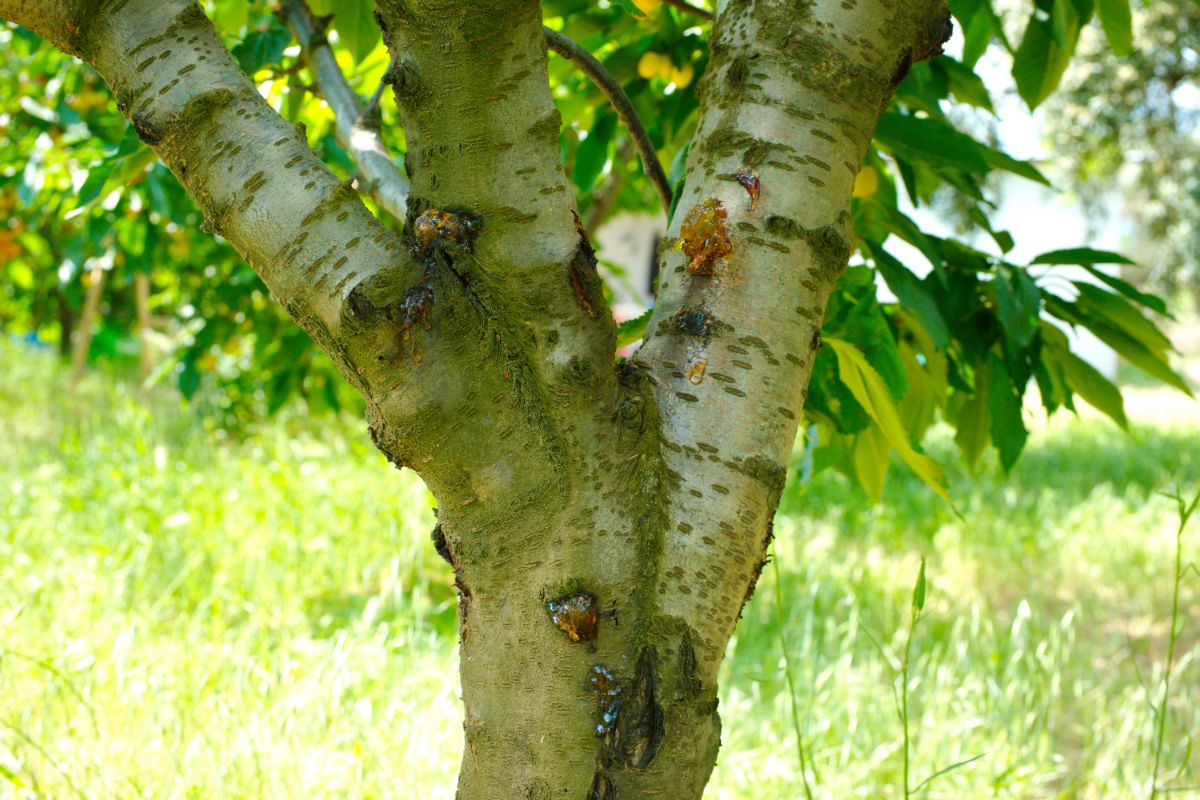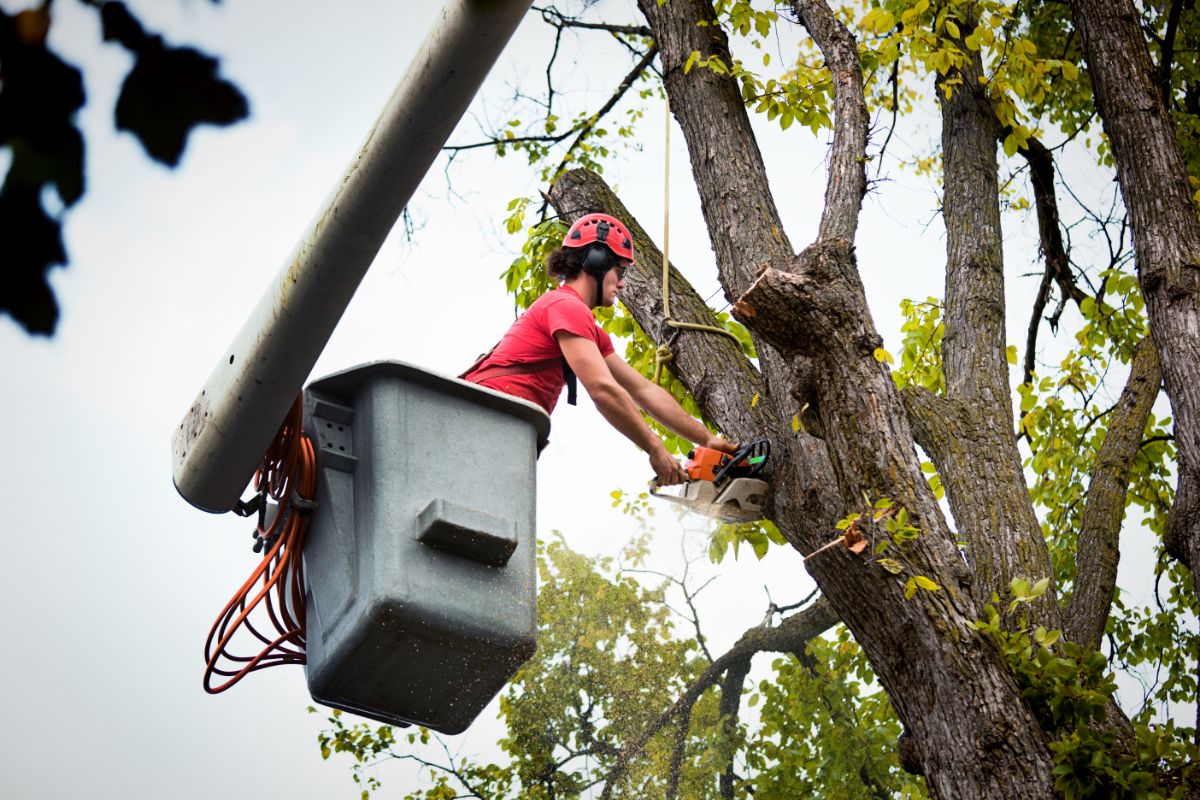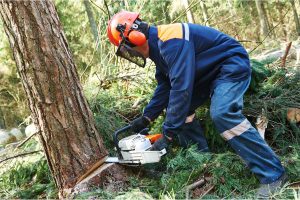Table of Contents
Suffering from ailing trees plagued by unknown diseases? This guide delves into identifying common tree illnesses based on symptoms, exploring causes, and detailing treatment options with associated costs. Gain valuable insights into key diseases like Anthracnose, Root Rot and Powdery Mildew.
Identifying Tree Diseases
Symptoms of Tree Diseases
There are several noticeable symptoms to look out for when trying to identify potential diseases affecting trees. Discoloured or abnormally shaped leaves are one of the most obvious signs that something is amiss. Leaves that are yellowing, browning, curling, wilting, or developing spots can all indicate issues like fungal infections, bacterial diseases, viral infections or environmental stresses.
Trees that are losing leaves and foliage earlier or more rapidly than expected may also be exhibiting disease symptoms. Excess leaf drop that leaves branches barren can point to root or vascular diseases impeding the tree’s ability to transport water and nutrients.
Abnormal growths like cankers, galls or tumors on the bark or branches can also be symptomatic. Cankers often look like sunken, dead areas of bark and are frequently caused by fungal or bacterial infections. Galls are tumor-like overgrowths resulting from infestations of insects, mites or fungi.
Additionally, take note of any oozing sap seeping from the bark or branches, which usually signifies infection or infestation. Fungal fruiting structures like mushrooms, conks and brackets growing on the bark are other visual cues of potential disease issues.
Overall, keep an eye out for any deformities, wounds, rotting, wilting, dying limbs or other signs of decay that seem anomalous for the tree species and time of year. Early detection of disease symptoms gives you the best chance to identify and address the underlying causes.
Causes of Tree Diseases
There are a variety of biotic and abiotic factors that can cause trees to develop diseases. Fungal pathogens are one of the most common culprits of infectious tree diseases. Fungal spores infect trees through openings in the bark and wounds. These fungi spread through the vascular system, interrupting the transportation of water and nutrients. Dutch elm disease, oak wilt, verticillium wilt and armillaria root rot are some examples of serious fungal diseases.
Bacterial diseases like fire blight, bacterial leaf scorch and citrus canker are another major cause of tree illnesses. Bacteria infiltrate the xylem and multiply, creating blockages and destroying tissue. Bacterial infections often stem from vulnerable wounds or entry points.
Tree diseases can also be caused by other microbes like phytoplasmas and viruses.
Phytoplasma infections result in yellowing leaves, stunted growth and plant decline. Viral infections can create mosaic patterns on leaves, ringspots, growth abnormalities and other issues.
On top of biotic pathogens, environmental stressors like drought, flooding, extreme temperatures and pollution can also lead to tree diseases. These abiotic factors create physiological stress that makes trees more prone to pests and pathogens. Appropriate cultural practices and preventative care are key to avoiding environmental diseases.
By understanding the various fungal, bacterial and environmental factors that commonly lead to tree diseases, you can better monitor for risks and proactively protect tree health.
Early Signs and Detection
Catching tree diseases early is crucial to prevent escalation and irreversible damage. Therefore, it’s important to routinely inspect trees for any early indicators something may be amiss. Look for subtle initial symptoms like isolated spots on leaves or bleeding cankers on branches that haven’t yet spread.
Prompt disease detection allows for timely treatment before the pathogens proliferate or the issues become fatal. For instance, removing an infected branch immediately after spotting a fungal conk can potentially save the whole tree. Early intervention maximises treatment efficacy and may curb the disease from advancing to a point beyond recovery.
Establishing a monitoring schedule is advisable to stay on top of tree health. Monitor for diseases during both growing and dormant seasons, as different signs emerge at varying times of year. Keep an eye out after events like storms that can wound trees and create entry points for pathogens. Observe trees after transplanting or pruning as well, as these practices stress trees and increase vulnerability.
In essence, vigilant monitoring and early detection provides the best chance of successfully identifying, managing and treating tree diseases before lasting damage is done. If caught early, many tree diseases can be arrested through prompt treatment methods like pruning out infection, applying fungicides or improving cultural practices. Stay observant of your trees and be proactive about disease prevention and management.
The key is looking for early symptoms, understanding the various biotic and abiotic causes, and detecting issues promptly before they escalate out of control. With some diligence and proper care, many tree diseases can be effectively mitigated.

Common Tree Diseases in Australia
Overview of Root Rot
Root Rot is a common fungal disease affecting trees in Australia, particularly in areas with poor drainage or excessive soil moisture. The fungi infect the roots of trees, causing them to decay and impair the tree’s ability to transport water and nutrients. Trees suffering from Root Rot exhibit symptoms like stunted growth, yellowing foliage, thinning canopy, and eventual death.
The disease is most problematic in native species like eucalypts and acacias. Improving drainage around trees can help prevent Root Rot, along with applying fungicides to protect healthy roots. Understanding Root Rot and its preference for moist soils can guide treatment and prevention.
Understanding Powdery Mildew
Powdery Mildew is another fungal disease prevalent on trees in Australia. This disease flourishes in humid, shady environments and is identifiable by the white powdery coating it creates on the surface of leaves. While mainly aesthetic, heavy Powdery Mildew infestations can stunt foliage growth and weaken trees over time.
The fungal spores spread easily via wind and thrive in dense, poorly ventilated canopies. Pruning branches to improve airflow and applying neem oil during early stages can help control Powdery Mildew. Being able to identify the powdery white substance and addressing it promptly is key to protecting tree health.
Delving into Seiridium Canker
Seiridium Canker is a fungal disease that infects the bark of trees like cypresses, creating sunken canker lesions that girdle limbs and trunks. The disease thrives in wet conditions and enters trees through wounds and cracks in bark. Infected trees exhibit dieback, resin oozing from cankers, and eventual death.
Pruning out early infections and avoiding unnecessary wounding of bark helps prevent escalation. Fungicides may be applied at early stages as well. Understanding Seiridium Canker and its impacts allows prompt identification and treatment when discovered.
Specific Diseases and Treatments
This section dives into specific diseases affecting trees in Australia and their respective treatments, offering a deeper understanding of managing these diseases.
Detailing Anthracnose Disease
Anthracnose is a fungal disease often affecting ornamental trees. It thrives in wet conditions and causes blotchy, brown dead areas on leaves and twigs. Infected leaves drop early and heavy defoliation can occur. Apply protective fungicide sprays like chlorothalonil or propiconazole at bud break and repeating every 7-14 days during wet weather.
Prune out infected branches and rake up fallen leaves to reduce inoculum. Fertilizing to promote growth and mulching to minimize splash dispersal can help manage Anthracnose as well. Understanding Anthracnose’s affinity for moisture guides cultural practices. Prompt treatment prevents major defoliation events.
Exploring Myrtle Rust
Myrtle rust is a fungal disease heavily impacting Australia’s native Myrtaceae plant family. Yellow powdery eruptions on leaves and twigs that turn reddish-purple signify Myrtle rust. Preventive fungicide spraying using products containing tebuconazole provides protection.
Pruning infected branches limits spread. Remove and destroy severely infected plants. Plant resistant species like Darwin stringybark and lemon myrtle in high risk areas. Avoid unnecessary pruning during wet conditions when spores release. Myrtle rust has devastated susceptible natives, so prompt treatment and preventive practices are imperative.
Unveiling Cypress Canker
Cypress Canker is a fungal disease prevalent in Australian cypress trees. Cankers form on branches and trunks oozing resin. Dieback occurs in infected areas. Pruning out early infections provides effective control. Avoid unnecessary injury and stress to trees. Apply preventive fungicide sprays containing copper in susceptible species like Leyland cypress.
Promote air circulation and leave adequate spacing when planting new cypresses. Fungal treatments may be applied to protect uninfected trees adjacent to those with advanced Canker. Sanitation and reducing moisture are key to limiting this aggressive disease. Early intervention is essential to avoid lasting damage.
These examples provide deeper insight into specific diseases impacting Australian trees, and methods to identify, treat, and prevent them. Understanding disease specifics, following preventive practices, and consulting professionals enables appropriate care for your landscape trees. With proactive management guided by knowledge, destructive tree diseases can be overcome.
Professional Diagnosis and Treatment
The Role of Arborists
When suspecting a tree disease, it’s advisable to engage professional arborists for assessment and diagnosis. Arborists are specially trained in identifying diseases based on symptoms and experience. They can provide an accurate diagnosis where home diagnosis may be uncertain. Arborists also have extensive knowledge of effective treatment options suited for specific diseases and trees.
Relying on the expertise of arborists is recommended to ensure proper identification and appropriate treatment. They have the skills to thoroughly inspect trees and take samples for laboratory testing when needed. Their specialized training allows them to strategize effective disease management plans. Engaging arborists provides the best chance of arresting diseases and restoring tree health.
Diagnosis Methods
Arborists use various methods to diagnose tree diseases. Initial visual inspection of symptoms provides key preliminary clues. They look for signs like discolored or dropping leaves, fungus growth, bark abnormalities and girdling. Aerial inspection provides a thorough overview of the full tree and canopy.
Lab tests of soil, tissue, water or fungal samples may be conducted for confirmation. Culturing reveals the specific pathogens present. DNA tests identify genetic markers of diseases. This laboratory analysis provides definitive diagnosis when visual symptoms are inconclusive.
Overall, arborists synthesize clinical lab tests with their visual inspection and expertise to make an accurate diagnosis. This enables them to pinpoint specific diseases from general symptoms. A combination of visual and laboratory diagnosis allows proper identification.
Treatment Options
Once diagnosed, arborists determine the most effective treatments. For minor foliar diseases, fungicides may be sprayed on leaves. Soil treatments like trenching or drenching with fungicides can manage certain root diseases. Injecting systemic treatments directly into the tree may be utilized as well.
Severely infected trees may need pruning of diseased limbs and branches to prevent spreading. As a last resort, removal may be recommended for extensively damaged trees. Professional treatments are designed to arrest and cure diseases whenever possible, and only recommend removal when truly necessary.
With their breadth of treatment knowledge and tools, arborists can provide customized disease management plans tailored to your specific trees and issues. This offers the best chance of restoring tree vitality in the face of disease. Trust their expertise in diagnosing and treating any suspected illnesses.
Cost of Treatment
Factors Affecting Treatment Cost
Several key factors influence the cost of treating a diseased tree. The extent of infection and how far the disease has progressed is a major determinant. Treating early-stage issues is more affordable than managing advanced diseases that require extensive treatment or removal. The size, maturity and species of the tree also impacts costs. Larger, older tree require more intensive treatment.
Location is another consideration, as accessibility affects equipment needs. Treating a remote tree deep in a forest is more challenging than one in an open yard. Disease type also plays a role, as some require simple spraying while others need intensive root treatment.
In general, the more involved the treatment, the higher the costs. Basic spraying of fungicides averages $150-500 depending on tree size. Soil drenching and injections range from $500-2000. Extensive root treatment can cost $2000-5000. Supporting weak limbs with cables and braces is $200-600 per limb. And severely infected trees may need removal at $1000-5000 depending on size and location.
Working with professional arborists and tree care companies is recommended to determine accurate treatment plans and pricing for your specific situation. Be wary of contractors offering bargain pricing, as this may indicate cutting corners. Investing in qualified expertise helps ensure effective treatment and long-term solutions.
Average Cost Estimates
To provide a general sense of potential treatment costs, here are some average price estimates from reputable tree care providers:
- Fungicide spraying – $250-750 depending on coverage needed
- Soil trenching and drenching – $1000-2000 for a medium tree
- Root collar excavation – $2000-5000 depending on depth
- Trunk injection treatment – $300-600 per injection site
- Support cabling – $200-400 per limb
- Disease resistant tree replanting – $400-1200 depending on size
These averages demonstrate the wide cost range based on tree factors. Within each treatment, costs also depend on:
- Diagnosis fees – $100-300
- Labor for treatment application – $50-150/hour
- Equipment fees for lifts, tools, etc. – $100-500/day
- Product costs for fungicides, nutrients, etc. – $50-500
- Travel fees if located remotely – $50-200
Consider all these cost components when budgeting potential tree disease treatments. It is an investment in the long-term health and longevity of your trees.
Long-term Financial Benefits
While tree disease treatment entails significant upfront costs, it provides major long-term financial benefits well worth the investment. Immediate treatment can arrest diseases before they escalate and cause extensive damage requiring expensive solutions like full tree removal. Investing in timely treatment can prevent much larger future expenses.
Additionally, healthy trees add considerable value to properties. Diseased trees drag down aesthetics and perceived home values. Well maintained trees can increase property values from 5-15%. Property with dying trees can decrease value by the same amount. Investing in treatment preserves your property investment and prevents devaluation from declining trees.
The costs of ignoring diseases and allowing trees to die necessitate expensive removal and replacement. Treatment and prevention safeguards your existing trees and avoids this significant future expense. It also avoids potential property damage and legal liability from falling limbs or full tree collapse – outcomes which can cost tens of thousands in repairs and legal fees.
While not inexpensive, treatment provides long-term benefits and financial protection well justifying the initial expense. The old adage “an ounce of prevention is worth a pound of cure” rings very true for managing tree diseases. The short-term savings of neglecting diseases leads to exponentially higher long-term costs in the future. Be proactive and work with professionals to protect your tree investments.

Preventive Measures
Preventive Treatments
Being proactive with treatments can help prevent many tree diseases from taking hold. Applying preventive fungicide sprays provides protection against foliar pathogens. Spraying copper-based bactericides when disease pressure is high prevents infections. Keeping trees on a regular fungicide injection schedule also helps maintain health.
For root diseases, soil drenches and injections with fungicides around the root zone of vulnerable trees prove effective. Installing preventive root collars and flares provides protection against root rot. Being vigilant with preventive treatments is less costly than managing full-blown infections.
It’s advisable to have arborists inspect trees regularly and recommend appropriate preventive treatments based on risks. Taking these proactive measures before diseases emerge is fundamental to sustainable tree health management. An ounce of prevention truly is worth a pound of cure when caring for trees.
Regular Monitoring and Inspection
In conjunction with preventive treatments, consistent monitoring and inspection allows early disease detection and rapid response. Observe trees routinely for any symptoms of infections or other issues. Monitoring should incorporate both aerial and ground inspections. Look carefully for subtle early signs like spots, wilting leaves or bleeding cankers.
It’s also beneficial to have professional arborists thoroughly inspect trees twice annually. Their expertise facilitates detecting nuanced symptoms you may overlook. They can also perform laboratory diagnostics on suspicious issues to determine if pathogens are present before visible symptoms manifest. Taking action at the first sign of disease is crucial for effective treatment.
Scheduling annual treatments at optimal times with experienced tree care providers is a prudent preventive practice as well. Their knowledge of seasonal risks and vulnerabilities directs proactive interventions. Relying on professionals helps ensure vigilant monitoring and early disease detection.
Community Awareness and Education
Preventing some highly infectious tree diseases requires community-wide participation. Because diseases can spread between properties and neighborhoods, area-wide education and cooperation is key. For example, Dutch elm disease has devastated elm populations by spreading rapidly from tree to tree. But instituting a community effort to promptly remove infected trees has proven effective.
Local workshops to identify common diseases helps residents recognize issues early and report them. Quick reporting and removal of infected public trees before diseases proliferate is imperative. Neighborhood volunteers supporting these efforts multiplies community impact. Additionally, outreach with preventive treatment subsidies for income-challenged residents ensures area-wide participation.
A collective community understanding of tree diseases, and coordinated responsibility for monitoring and swift response upon detection, helps keep entire neighborhoods protected. Residents should welcome arborists to inspect their property and be willing to promptly treat or remove diseased trees. With teamwork and education, whole communities can stay vigilant against destructive tree diseases.
In essence, integrating preventive treatments, vigilant monitoring, early detection, and community cooperation offers the best protection against tree diseases taking hold and spreading havoc. Being proactive protects property investments and the shared community landscape. With some diligence and teamwork, many destructive tree diseases can be contained.
Related Tree Resources

How Much Does Tree Felling Cost?
The national average tree felling cost in Australia is around $870 per tree, but it can differ depending on your location and the size of

